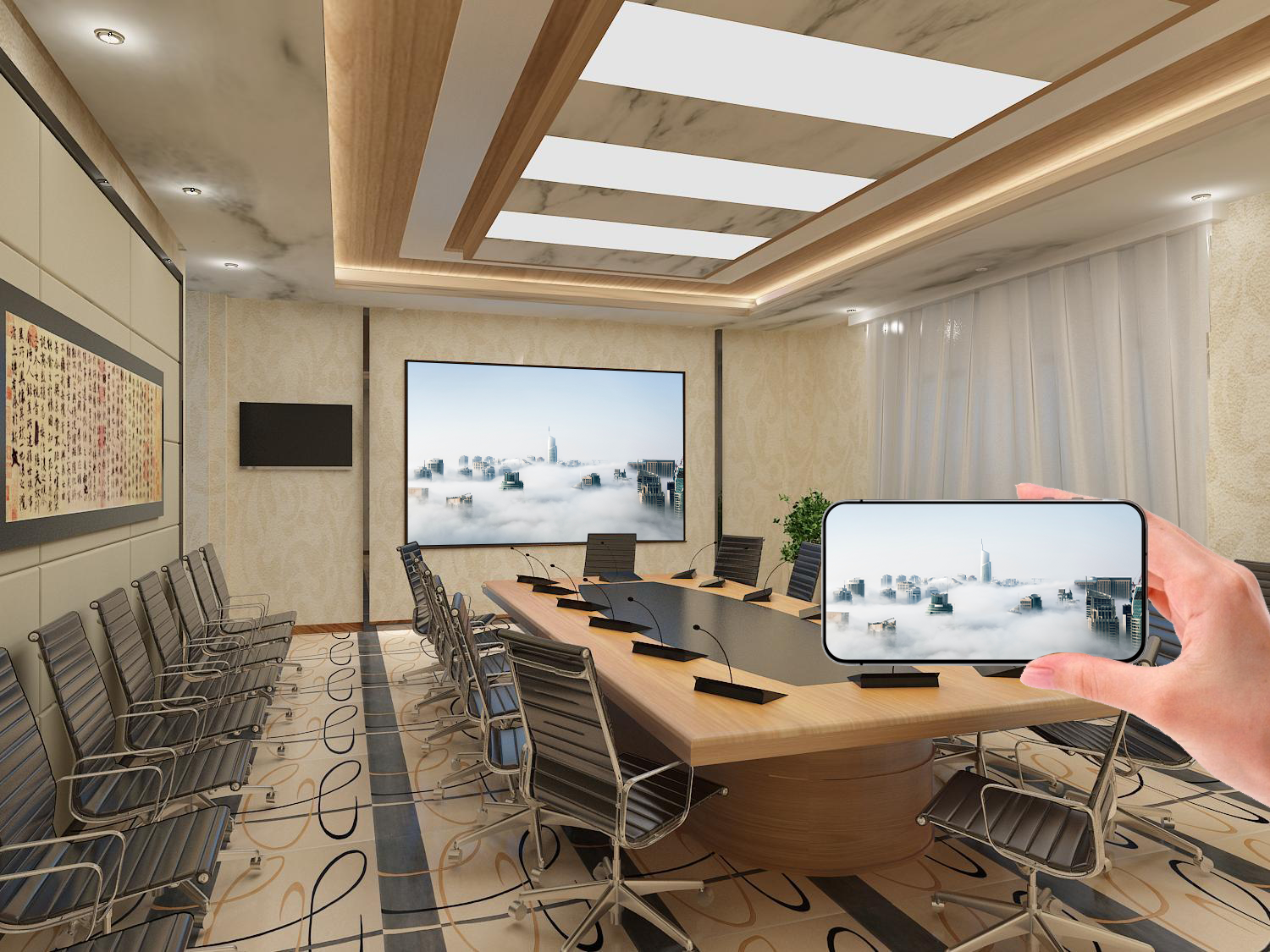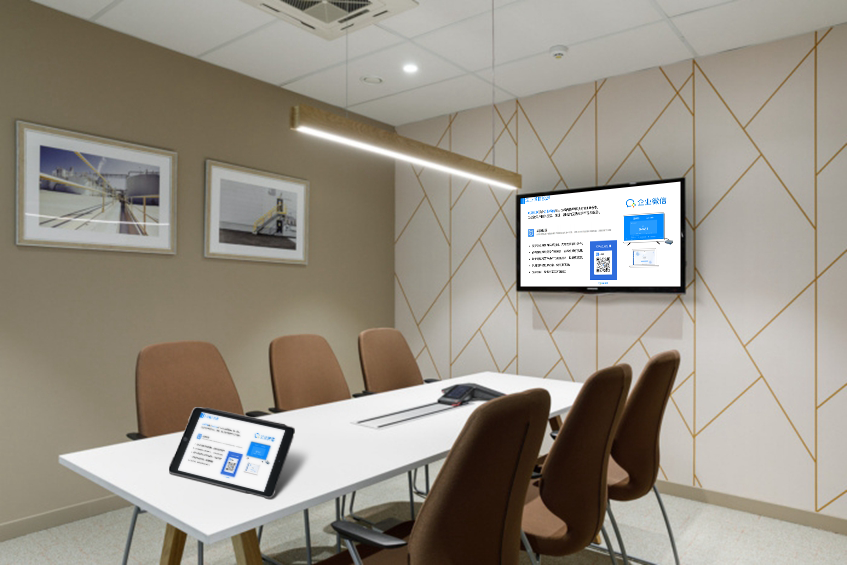Screen Mirroring: A Solution for All-Scenario Efficient Interconnection
The screen mirroring solution focuses on pain points in device interconnection such as “cumbersome connections, poor compatibility, and laggy experience.” Leveraging proprietary wireless transmission technology, it builds a full-link mirroring system that covers office, education, meetings, and retail scenarios, making content interaction between terminals like phones, computers, and tablets and a large screen simpler, more stable, and more efficient.
Core Technology Advantages
- Universal Protocol Compatibility Engine: It supports over 10 mainstream mirroring protocols such as AirPlay, Miracast, DLNA, and WiDi, and is deeply adapted to all system devices, including iOS, Android, Windows, macOS, and HarmonyOS. Through Bijie’s proprietary protocol conversion technology, older devices can mirror without a system upgrade, with a device compatibility rate of 99.9%, solving the problem of multi-brand device interconnection.
- High-Definition, Low-Latency Transmission: It uses a dual-band Wi-Fi 6 module and dynamic anti-interference algorithms to achieve 4K Ultra HD quality transmission. The frame rate is stable at 60fps, and latency is controlled within 30ms. Even in a complex environment with 10 devices mirroring at the same time, it maintains synchronized audio/video and a smooth screen, meeting the high-precision needs of displaying design blueprints and real-time data presentations.
- Diverse Connection Methods: It provides multiple methods such as “one-click mirroring, QR code mirroring, NFC tap-to-connect, and mirroring code connection,” completing device pairing in 3 seconds. For scenarios without a network, it supports a direct mobile hotspot connection. For fixed locations, mirroring permissions can be pre-set, allowing authorized devices to connect automatically when they are close, reducing the barrier to entry to a “zero learning cost.”
Key Function Design
- Multi-Device Collaborative Mirroring: It supports up to 8 devices mirroring at the same time and displaying them in a split-screen view. The main screen can freely switch between single-screen, four-split, and eight-split layouts. In a meeting, proposals from different departments can be presented side-by-side. In a class, the work of multiple groups can be compared simultaneously, increasing information retrieval efficiency by 60%.
- Two-Way Interactive Control: The large screen can reverse-control the mirrored device, such as directly flipping through a PPT on a phone or zooming in on a design blueprint on a computer. The smaller terminal can also remotely control the large screen’s volume and switch signal sources, freeing you from the constraint of “operating while standing in front of the device.”
- Content Security Control: A built-in multi-level permission management system supports a device whitelist, allowing only authorized terminals to mirror. For sensitive scenarios, a “mirroring review” function can be enabled, where content must be confirmed by an administrator before it can be displayed. The transmission process uses AES-256 encryption to prevent information leakage and protect business secrets and educational data.

Scenario-Based Implementation Solutions
(I) Enterprise Office Scenarios
- Conference Room Mirroring: A Bijie smart mirroring terminal is deployed. Attendees do not need to install any software and can use a phone or computer to mirror proposal documents and data reports with one click. It supports annotating the mirrored content on a touch-enabled large screen, with the changes synchronized to all terminals in real time, increasing meeting discussion efficiency by 40%. When paired with a Bijie meeting tablet, it can achieve a seamless integration of mirrored content and whiteboard writing, allowing creative ideas to be presented instantly.
- Remote Collaboration Mirroring: Off-site teams can use the Bijie Cloud Mirroring Platform to project their local content onto the main conference room screen in real time, with a split-screen display of the video feed. The revision suggestions that remote members annotate on their phones are synchronized to all terminals within 2 seconds, making the cross-regional collaboration experience comparable to being on-site and reducing communication costs by 50%.
(II) Smart Education Scenarios
- Interactive Classroom Mirroring: A teacher uses a tablet to mirror courseware to the classroom’s large screen. Using Bijie’s teaching software, they can launch a quiz, and students can use their phones to mirror their answers. The main screen generates an accuracy analysis in real time. It supports students’ terminals to “push” content to the large screen for display, and group discussion results can be compared in a split-screen view, increasing the frequency of classroom interaction by 3 times.
- Experimental Teaching Mirroring: The footage from a microscope or experimental instruments can be mirrored to the large screen via a Bijie collection box, allowing all students to clearly observe subtle changes. Students’ videos of the experimental process can be mirrored in real time to a group screen for members to analyze, improving the effectiveness of experimental teaching by 70%.
(III) Commercial Retail Scenarios
- Store Display Mirroring: A salesperson can quickly mirror a product promotion video or a 3D model from their phone to the store’s large screen. Customers can use a touch screen to rotate and view product details. It supports scheduled loop playback of mirrored content. When paired with the Bijie digital signage system, it can automatically switch promotional information by time slot to attract customer traffic and conversion.
- Exhibition Interaction Mirroring: Exhibitors can use a Bijie portable mirroring device to project a presentation from their laptop onto the booth’s large screen in real time. Visitors can get a digital copy of the mirrored content by scanning a QR code with their phones, and they can also annotate questions on their phones, with the interactive messages displayed on the main screen in real time, enhancing the exhibition experience.
Management and O&M System
- Smart Management Platform: Administrators can use the Bijie cloud backend to monitor the real-time operational status of all mirroring devices, including online status, mirroring frequency, and fault alarms. It supports remote power on/off, firmware upgrades, and parameter configuration. Batch operation efficiency is increased by 80%, and maintenance costs are significantly reduced.
- Data Statistics and Analysis: It automatically records data such as mirroring duration, device type, and content type, and generates multi-dimensional analysis reports. Enterprises can use this to optimize their conference resource allocation, and schools can understand the frequency of use for their teaching devices, providing data support for scenario optimization.
- Stable and Reliable Assurance: It uses an industrial-grade hardware design, supporting continuous operation for 7×24 hours, with an average time between failures (MTBF) of 50,000 hours. It is equipped with a backup wired connection port, which allows for a quick switch in case of a sudden network failure, ensuring that critical scenarios are not interrupted.
The core of the screen mirroring solution is “technology adapted to the scenario.” Through the deep collaboration of hardware, software, and a cloud platform, it upgrades simple “content projection” to an “efficient collaboration tool.” From a small discussion with a few people to a large exhibition with thousands, from a fixed conference room to a mobile scenario, it provides a consistent, high-quality mirroring experience, redefining the standard of device interconnection efficiency.